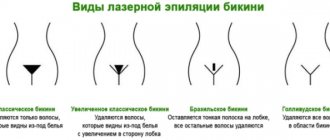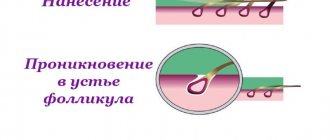What is electrolysis?
Electrolysis is a method of getting rid of body hair, which was discovered back in the 40s of the twentieth century. Its essence lies in the fact that, using a short thin needle, a specialist directs an electric discharge to the very root of the hair and thus destroys the structure of the hair bulb. The hair becomes weak and then falls out.
It is interesting to note that officially electrolysis is the only way to permanently remove hair .
The American organization Food and Drug Administration, which monitors medical procedures, has allowed the appropriate mark to be placed only for electrolysis.
Skin care after electrolysis
- Do not wet the treated area during the day.
- Treat the skin area twice a day, first with chlorhexidine, then with cindol.
- Do not touch the epilated area with unwashed hands.
- Do not apply creams and deodorants to your body (otherwise you will create a favorable environment for the development of bacteria)
- It is not advisable to apply cosmetics (foundation, lipstick, powder) to the face within 24 hours after the procedure.
- It is strictly forbidden to sunbathe and take sunbathing until the crusts are completely healed, otherwise age spots may form.
- It is forbidden to play sports, visit the sauna, take a hot shower, or swim in chlorinated water in the first week after the procedure.
- It is advisable to wear looser clothing to avoid irritation
These simple rules will help avoid skin irritation, speed up its healing and prevent the appearance of folliculitis.
How is electrolysis performed?
A professional cosmetologist knows that the electrolysis procedure is quite painful. Therefore, our cosmetologist will offer you options for painkillers, taking into account your individual tolerance to the drugs. Then the hair removal procedure itself begins.
Needles for electrolysis are sterile and very thin. They are introduced to a depth of 1 to 5 mm, depending on the treated area. The needle delivers an electrical discharge to the hair follicle, the follicle is destroyed, and the hair itself is removed using tweezers.
After the procedure, you cannot visit the bathhouse, sauna, swimming pool or solarium for a week. Redness and slight swelling may occur.
Prices for electrolysis at the World of Beauty salon
What are the consequences of electrolysis?
If the electrolysis procedure is carried out correctly and post-procedure care is followed, there will be no unpleasant consequences on the body. Burns and scars are a result of a novice specialist lacking the necessary experience and/or performing the procedure on a budget device at home.
Skin after electrolysis
A common skin reaction immediately after electrolysis is redness and swelling, all of which goes away within a few hours after the procedure.
Red dots (crusts) after electrolysis
Further, red dots remain at the site of the removed hair; in their place, after 2 days, barely noticeable crusts form, which dry out and fall off after about 2 weeks.
Where can you remove hair using electrolysis?
Electrolysis removes hair from both the body and face. It is important to remember that there are time limits that you need to find out about from a specialist.
For example, the area above the upper lip cannot be treated for more than 10 minutes at a time.
IMPORTANT: you cannot remove hair from the ears and nose using electrolysis; you should be careful when approaching this type of hair removal in the armpit area.
A professional cosmetologist performs the procedure quickly enough. However, you cannot choose speed at the expense of quality!
Contraindications to electrolysis
Since electrolysis is the work of a specialist with the skin, the main contraindications are related to diseases or damage to the skin:
- Inflammatory processes in the skin, including viral ones
- Acute and chronic skin diseases
- Malignant neoplasms of the skin
- Varicose veins (if the procedure is performed on the legs)
- Tendency to form scars (keloid disease)
There are also other restrictions:
- Diseases of the heart and blood vessels, including stroke and myocardial infarction
- Presence of all types of tumors
- Endocrine system diseases
- Mental disorders and epilepsy
- Intrauterine device (if the procedure is on the bikini area)
- Pregnancy (breastfeeding)
- Individual intolerance to metals and their alloys
- Presence of a pacemaker
- Severe forms of hypertension and coronary heart disease
- Diabetes
- Asthma
- Infectious diseases (Hepatitis, HIV, etc.)
Indications for the electrolysis procedure
As a rule, the main indication for hair removal (i.e. permanent removal of hair from the body and face) is the desire of the patient himself, who is tired of regular hair removal (plucking, shaving, waxing, etc.). However, it is possible that the reason for seeking help from a cosmetologist with this aesthetic defect may also be a disease (hypertrichosis, hirsutism). In this case, hair removal is carried out in parallel with treatment by an endocrinologist, gynecologist, etc.
Preparation
If you decide to remove hair this way, keep in mind that electrolysis is effective only at the stage of growing hair. That is, the length of the hairs must be at least 2.5 mm. The longer they are, the easier it is for the electrologist to get into the follicle. Therefore, for some time you need to abandon all methods of hair removal.
Before the session, you can cleanse your body with a scrub. It will exfoliate dead skin particles and cleanse the pores where the follicles are located. A shower or hot bath won't hurt either, since the next time you won't be able to wash yourself completely is at least a week later.
If you do not want to undergo injection anesthesia, two hours before the procedure, apply an anesthetic cream recommended by a cosmetologist to the desired areas of the body.
Before electrolysis, you can clean your body with a scrub.
Carrying out the procedure
Before the session begins, the skin in the treatment area is wiped with an antiseptic and numbed. The manipulation is performed with a disposable needle, which the doctor unseals before the start of the session. A neutral electrode is placed in the patient's hand, the doctor inserts a thin needle into the follicle and sends an electrical impulse into it.
The insertion of the needle is practically not felt; pain occurs only at the moment the current is turned on.
On average, the processing speed ranges from 5 to 15 hairs per minute. It depends on the device used and the experience of the cosmetologist. His task is to correctly evaluate and select the appropriate method and current parameters.
The pain does not appear at the moment of needle insertion, but during the application of current
After electrolysis is completed, the skin is again treated with an antiseptic solution and a healing cream with an antibiotic.
Radiofrequency electrolysis: advantages of the technique
The new device DEPIL PLUS 13MHz combines 2 complementary mechanisms of action:
- electrolysis (the hair root is destroyed by alkali and galvanic current);
- thermolysis (using radio frequency, tissues are heated to a temperature sufficient to cauterize the hair follicle).
As a result of simultaneous chemical and thermal effects on each hair follicle, the desired result is achieved much faster, and the risk of complications is practically eliminated!
Variety of indications for electrolysis
Radiofrequency electrolysis using the DEPIL PLUS 13MHz device can permanently remove hair:
- any location (except for the auditory canals and nasal passages);
- any color and thickness (light, gray, red, black; fluff, guard, etc.);
- on skin of any color (naturally dark, white with freckles and pigment spots, etc.).
Thus, unlike light hair removal methods, radiofrequency electrolysis has certain advantages and is guaranteed to remove hair that is resistant (insensitive) to other hair removal methods!
Safe and virtually painless
The new device for radiofrequency electrolysis has a unique system for automatic control of the entire hair removal process, and the use of a frequency of 13 MHz has made electrolysis almost painless!
However, the radiofrequency electrolysis procedure can only be performed by a cosmetologist with specialization in this technique and experience, because The aesthetic result largely depends on his skill, jewelry precision and professionalism!
Electrolysis - how to get rid of hair forever?
For many centuries, women and men have been trying to get rid of unwanted body hair in various ways. Today, there are many methods - razor and depilatory cream, sugaring and waxing are the most popular and inexpensive methods of hair removal, which, however, give a very short-term result - from one day to several weeks. But relatively recently, several methods of permanent hair removal have been invented - electrolysis, laser hair removal, photoepilation and the new elos-epilation.
About the first method - electrolysis
, which many consider the most effective and safest to date, we asked Sergei Dobrodon, a specialist in electrolysis and coagulation, to tell us about it.
What is electrolysis?
This is a method of hair removal by destroying the root using an electric current. A special needle (electrode) the size of a hair is applied to the root and, using a low-power current, destroys the bulb, leading to a complete loss of the hair's ability to grow. The method of hair removal using electrolysis is the most studied method of permanent hair removal. It was first used by American ophthalmologist Charles Michael in 1875 to remove ingrown eyelashes, and since 1880 this method of hair removal began to be used for non-medical purposes. Electrolysis has been studied for more than two centuries, thanks to which it has repeated medical confirmation of its effectiveness and safety. No other permanent hair removal procedure (photo, laser, elos) has such long-term follow-up and official recognition among doctors.
Unlike other hair removal methods, electrolysis can remove hair from any part of the face and body. It also doesn’t matter the color, hair or skin type.
Contraindications for electrolysis
Unconditional contraindications include diseases such as hepatitis, epilepsy, the presence of a pacemaker, oncology, intolerance to electric current, a tendency to form keloid scars, the presence of gold threads, metal implants, varicose veins in the area of the procedure. Conditional contraindications include diabetes, pregnancy and lactation, blood clotting disorders, and cardiovascular diseases. In these cases, prior consultation and permission from the attending physician is necessary.
I would especially like to mention people with hormonal disorders and taking steroid medications. In these cases, electrolysis is possible, but a specialist will not be able to guarantee a result that will suit you, because hormonal growth of new hair from “dormant follicles” is possible.
How does the electrolysis procedure take place?
The specialist inserts a thin needle (electrode) into the channel from which the hair grows, after which a current is applied to the needle, destroying the bulb, after which the hair is removed from the skin using tweezers. This is how the area is treated hair by hair. Some hairs have curved follicles, in which case you have to insert the electrode several times to get into the follicle. Thus, the duration of the procedure depends on the amount of hair in the treated area, its thickness and the shape of the root.
It is for this reason that, as a rule, the cost of the procedure is indicated not per area, but per time spent or number of impulses (which approximately corresponds to the number of hair removed), and without a personal consultation it is impossible to determine how much time and sessions will be needed for you. Sometimes the procedure must be repeated 2-3 times on the same area. This is due to the fact that hair does not grow evenly and has three main stages of growth: anagen - the growth phase, catagen - the phase of root death, telogen - hair loss and the formation of a new bulb.
How many procedures do you need to do to get rid of hair forever?
Permanent hair removal is possible only in the anagen stage, i.e. in the hair growth phase. It is in this phase that it is possible to destroy the bulb. When it dies, despite the fact that the hair is still in the canal, it cannot be destroyed. Therefore, new hair will definitely grow in this place. Two or three sessions make it possible to get into the growth phase of those hairs that were in a dormant or dying state during the previous session. On average, 70-85% of hair is in the growth phase, which means you can count on significant results after the first procedure.
Is electrolysis painful?
It is important to understand that despite the name of the procedure ELECTRICAL hair removal and the accompanying word “current”, you will not experience any electrical discharges at all. The current flowing through the electrode is converted into heat (thermolysis) and heats the surrounding tissue, causing coagulation. I offer all my clients to try the procedure without pain relief, and most often I hear: “Is that all?”, and then we continue the procedure. If electrolysis seems painful, then anesthesia is applied using a cream without causing any discomfort.
How to prepare for the electrolysis procedure?
There are no particular difficulties here. The day before and on the day of the procedure, avoid drinking alcohol and consuming salty foods, as this leads to dehydration and deterioration of skin electrical conductivity. Immediately before the procedure, it is advisable to drink more water and eliminate coffee.
As for the length of the hair, 3-4 mm is enough. It can be longer. There have been cases when my clients said that they skipped the procedure because... the length of the hair seemed to them too short or too long, after which they shaved off the hair and waited for it to grow back. You don’t have to worry, long hair won’t prevent a specialist from performing electrolysis. And to make sure that it is sufficient, try to take the hair with tweezers; if you succeed, then this means that it is enough to work with it.
What care is needed after electrolysis?
After the procedure, do not injure the skin; postpone procedures such as peeling, scrub, cleansing until complete recovery. Try to avoid using saunas and gyms for 48 hours to avoid sweating on treated areas. Do not use cosmetics or perfume in the hair removal area. Avoid tanning beds to prevent pigmentation problems.
After and even during electrolysis, skin redness, swelling, and red dots are possible. You have 48 hours not to panic - this is the period during which the swelling will go away and the skin will recover. However, this fact should be taken into account, especially when it comes to the face area. You should not go for electrolysis if you have important negotiations or a date the next day. Red dots may become crusty, which will disappear within 7-10 days. Do not pick them out under any circumstances to avoid pigmentation disturbances and scarring. If after 2 days the swelling remains, inflammation, suppuration has begun, yellow crusts have formed, urgently call your cosmetologist or consult a doctor, the worst thing you can do is self-medicate.
Expert advice from a master
Important! Under no circumstances agree to have your own “individual needle” that will be used next time. All needles are disposable and must be disposed of immediately after the procedure. Are the small savings worth the risk to your health? Ask to open the disposable needle so that you can see it. When visiting an electrolysis specialist, do not hesitate to ask him for certifications. Believe me, you will never offend a specialist with your request. On the contrary, for example, I am only pleased to show off documents, and I myself draw the clients’ attention to how the sterile needle is packaged, hand it over and ask them to pay attention to the process of removing it from the blister. Don't be afraid to ask "stupid" questions, because they don't exist. If your cosmetologist is annoyed by your questions, most likely it is because he does not know how to answer them, and this, in turn, should alert you.
If you have any questions for me personally, I will be happy to answer them and advise you. The consultation is completely free. The cost of my services is one of the lowest in Moscow - 20 rubles / min (needle - 200 rubles, paid separately). I accept appointments at the cosmetology office of the AMARILLIS beauty studio, online registration via the link.
Your specialist in electrolysis and coagulation, master of sugaring,
Sergey Dobrodon.











